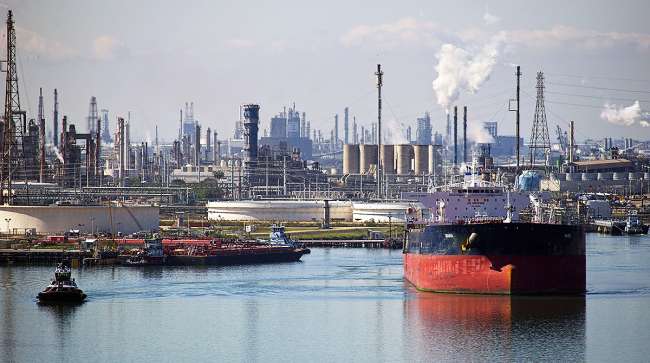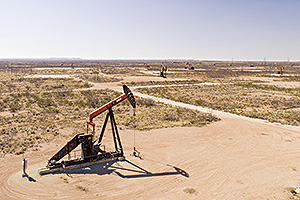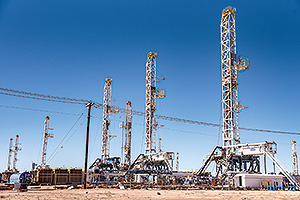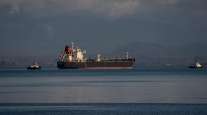Race Is on to Build Offshore Oil Export Terminals

[Stay on top of transportation news: Get TTNews in your inbox.]
A glut of oil is headed to the Gulf Coast in the months and years ahead.
That development is triggering a race among a growing number of entrants to build deepwater crude export terminals in the Gulf of Mexico to ship most of that oil to foreign markets.
Companies have proposed at least eight offshore oil-export terminals — many requiring billions of dollars in investment. They would stretch from off the coast of Brownsville, Texas, to southeastern Louisiana and take advantage of a new flood of crude from the booming Permian Basin as several pipelines connecting West Texas and the Gulf Cast near completion.

Pumpjacks operate on oil wells in the Permian Basin in Crane, Texas. (Daniel Acker/Bloomberg)
Two key factors are driving the rush to build offshore terminals: All that oil has to go somewhere, and increasingly crowded ports in Houston and Corpus Christi can’t efficiently load the biggest supertankers.
“The congestion is shifting from the Permian Basin to the Gulf Coast,” said Sandy Fielden, director of oil and products research at investment research firm Morningstar. “There’s lots of traffic that these offshore terminals can sort of bypass.”
Energy analysts expect only two or three of the eight proposals to get built, but the long list of potential projects is a response to the limitations of Gulf Coast ports, which aren’t deep enough to completely fill the world’s largest crude tankers.
The constraints are particularly exasperating for Corpus Christi, which has pipelines from the Permian coming online now through early next year, carrying up to 2.5 million barrels of additional crude per day. The Port of Corpus Christi has worked for years to acquire federal funding to deepen its channel while proposing an export terminal near Port Aransas. In the meantime, other parties have proposed deepwater terminals farther off the coast.
But these projects, which would require miles of underwater pipelines, are at least three years away from completion, slowed by environmental reviews and other issues, including the need to move cautiously since a pipeline or tanker accident could trigger a major Gulf oil spill. That translates into a short-term glut of Gulf Coast oil and distressed prices starting this year and worsening in 2020, Fielden said.
All of this proposed growth is the result of the shale oil boom in the Permian Basin. The Permian is producing close to 4.4 million barrels of oil per day — more than one-third of the nation’s record production — making it the most prolific oil field in the world. At the beginning of this decade, the Permian wasn’t even producing 1 million barrels daily.

Oil rigs stand in the Permian Basin area of Odessa, Texas. (Sergio Flores/Bloomberg)
The Permian’s lighter grades of crude oil aren’t as compatible with the Gulf Coast refining system, which was configured years ago to process heavier crudes from South America, the Middle East and Africa. But Texas crude is desired internationally, especially in Asian markets, meaning that most of the Permian oil is and will continue to be shipped overseas.
Since Congress lifted the nation’s decades-old crude export ban at the end of 2015, crude exports have steadily risen to nearly 3 million barrels a day, shipped primarily from the Houston, Beaumont and Corpus Christi regions. Those export volumes could double within a few years.
But exporting crude from the Gulf Coast remains an inefficient system. The biggest oil tankers in regular service, called very large crude carriers (VLCCs), can’t take on full cargoes from existing docks. VLCCs typically are about 1,000 feet long, or almost three football fields, and can carry about 2 million barrels of oil at a time.
Galveston Bay and some Corpus Christi docks can accommodate VLCCs, but the channels aren’t deep enough to fill the tankers. They are partially loaded at dock and then get topped off in deeper waters by another vessel, a time-consuming and expensive process known as reverse lightering.
It can take 10 days to completely load a VLCC under these conditions, often requiring multiple ship-to-ship transfers. Some of the offshore export terminal proposals would allow VLCCs to take on full cargoes in just 24 hours.
The only existing offshore terminal is the Louisiana Offshore Oil Port, called LOOP, which opened almost 40 years ago to import crude. It recently was converted for exports and began shipping oil overseas last year.
Also last year, Houston company Enterprise Products Partners, the nation’s leading crude exporter, became the first player to propose an offshore oil export project. A slew of others have followed. Enterprise’s Sea Port Oil Terminal, called SPOT, would be built about 30 miles south of Freeport.
Enterprise said last month that it has partnered with oil major Chevron as its primary customer on the project, and construction would begin once its application is approved by the federal Maritime Administration. Since these projects must be reviewed by several agencies, including the Coast Guard, construction isn’t expected to start until next year at the earliest.
Chevron has become one of the top producers in the Permian Basin, where the company expects to increase its output to nearly 1 million barrels of oil equivalent a day within five years. “As our production scales up, we will have the means to get those energy resources to the market,” said George Wall, Chevron’s supply and trading president.
Enterprise is competing with other projects offshore of Freeport that include the Texas COLT plan — crude offshore loading terminal — led by Canadian pipeline company Enbridge, and the Texas GulfLink project by Dallas-based Sentinel Midstream.
Analysts believe Enterprise has the advantage as the first mover with a strong track record of exporting fuels and Chevron’s backing.
Offshore of Corpus Christi, Houston refiner Phillips 66’s Bluewater Texas project is racing against the Texas Gulf Terminals effort led by Swiss commodities trader Trafigura. The Trafigura project had a head start, but the Port of Corpus Christi is backing Phillips 66’s larger project. Trafigura is facing opposition and additional environmental assessments because of its closer proximity to the Padre Island National Seashore.
The Ship Channel expansion project, which officially commenced this week, will support the incredible growth of #energy production in West Texas from the Permian and Eagle Ford regions. #MovingAmericasEnergy pic.twitter.com/hRuUmQiS7C — Port Corpus Christi (@PoccaPort) May 29, 2019
The Port of Corpus Christi also is working with private equity Carlyle Group to build an onshore terminal that can accommodate VLCCs at Harbor Island, but lengthy environmental reviews still are required before conducting the necessary dredging.
Other alternative projects range from Jupiter Energy Group’s proposed export project offshore of Brownsville to Tallgrass Energy’s crude terminal proposal off of the southeastern tip of Louisiana. Jupiter, of Houston, also aims to build a crude pipeline from West Texas to Brownsville.
“You can build all the dock space you need, and it’s not congested like Houston or Corpus Christi,” Jupiter CEO Tom Ramsey said of the Brownsville proposal.
Tallgrass’ Plaquemines Liquids Terminal effort in Louisiana involves building a new pipeline to carry crude from the Midwest, including oil from the Bakken shale in North Dakota, the Rockies and Canada. The reversal of the existing Capline pipeline also will bring more oil from up North to Louisiana.
“That new influx of crude will have to go somewhere,” said Jason Reeves, Tallgrass’ terminals general manager. “The world likes that light crude that U.S. shale does best. The Asian markets like it, and we produce it. You’ve got to get from A to B.”
Reeves predicts three projects will be built, one offshore of Freeport, one by Corpus Christi and, of course, the Tallgrass proposal.
Ethan Bellamy, an energy analyst at financial services company Robert W. Baird & Co., said at least two projects, including Enterprise’s SPOT, will eventually get built. For now, these proposals are like the slew of liquefied natural gas export terminals proposed within the past several years, of which he expects only a few to come to fruition.
“Right now, it’s a tossup. I’m not sure who will win, but we probably need another 2 million barrels per day of export capacity over the next five years,” Bellamy said. “Someone will get it done.”
Distributed by Tribune Content Agency, LLC




